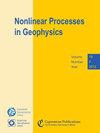Application of Advection-Diffusion Equation for Nonlinearly Evolving Precipitation Field
IF 2.4
4区 地球科学
Q3 GEOSCIENCES, MULTIDISCIPLINARY
引用次数: 0
Abstract
Abstract. Analytic solutions for the Advection-Diffusion equation have been explored in diverse scientific and engineering domains, aiming to understand transport phenomena, including heat and mass diffusion, along with the movement of water resources. Precipitation, a vital component of water resources, presents a modeling challenge due to the complex interplay between advection-diffusion effects and source terms. This study aims to improve the modeling of nonlinearly evolving precipitation fields by specifically addressing advection-diffusion equations with time-varying source terms. Utilizing analytic solutions derived through the integral transform technique, we modeled the time-varying source term and investigated the correlation between advection-diffusion and source term effects. While the growth of the field is mainly influenced by the amplitude, size, and timescale of the source term, it can be modulated by advection and diffusion effects. When the timescale of source injection is significantly shorter than the dynamic scale of the system, advection and diffusion effects become independent of the field growth. Conversely, when the timescale of source term injection is sufficiently long, the system evolution primarily depends on advection and diffusion effects. In turbulent regimes with strong diffusion and weak advection effects, a quasi-equilibrium state between growth and decay can be established by regulating the decay caused by advection. However, in regimes where advection effects are crucial, the decay process predominates over the growth process.应用非线性演变降水场的平流-扩散方程
摘要人们在不同的科学和工程领域探索了平流-扩散方程的解析解,旨在理解包括热量和质量扩散在内的传输现象以及水资源的流动。降水是水资源的重要组成部分,由于平流-扩散效应和源项之间复杂的相互作用,给建模带来了挑战。本研究旨在通过专门解决具有时变源项的平流-扩散方程,改进非线性演变降水场的建模。利用积分变换技术得出的解析解,我们对时变源项进行了建模,并研究了平流-扩散效应与源项效应之间的相关性。虽然场的增长主要受源项振幅、大小和时间尺度的影响,但它也会受到平流和扩散效应的调制。当源注入的时间尺度明显短于系统的动态尺度时,平流和扩散效应就与场的增长无关。相反,当源项注入的时间尺度足够长时,系统演化主要取决于平流和扩散效应。在扩散效应强而平流效应弱的湍流状态下,可以通过调节平流引起的衰减来建立增长和衰减之间的准平衡状态。然而,在平流效应非常重要的情况下,衰变过程会优先于生长过程。
本文章由计算机程序翻译,如有差异,请以英文原文为准。
求助全文
约1分钟内获得全文
求助全文
来源期刊

Nonlinear Processes in Geophysics
地学-地球化学与地球物理
CiteScore
4.00
自引率
0.00%
发文量
21
审稿时长
6-12 weeks
期刊介绍:
Nonlinear Processes in Geophysics (NPG) is an international, inter-/trans-disciplinary, non-profit journal devoted to breaking the deadlocks often faced by standard approaches in Earth and space sciences. It therefore solicits disruptive and innovative concepts and methodologies, as well as original applications of these to address the ubiquitous complexity in geoscience systems, and in interacting social and biological systems. Such systems are nonlinear, with responses strongly non-proportional to perturbations, and show an associated extreme variability across scales.
 求助内容:
求助内容: 应助结果提醒方式:
应助结果提醒方式:


